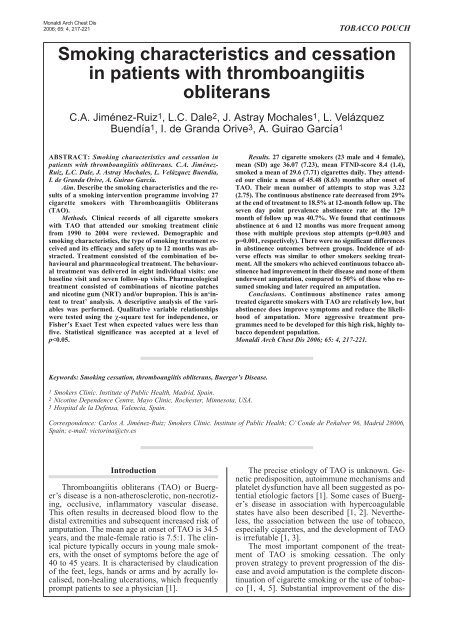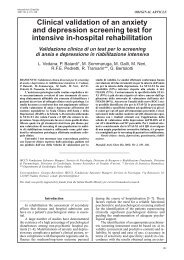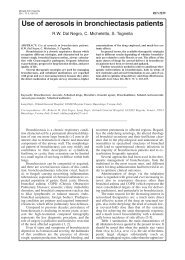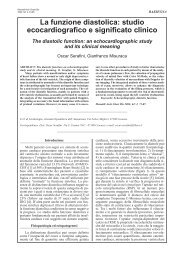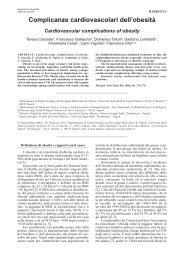Smoking Characteristics And Cessation In Patients With
Smoking Characteristics And Cessation In Patients With
Smoking Characteristics And Cessation In Patients With
You also want an ePaper? Increase the reach of your titles
YUMPU automatically turns print PDFs into web optimized ePapers that Google loves.
Monaldi Arch Chest Dis<br />
2006; 65: 4, 217-221 TOBACCO POUCH<br />
<strong>Smoking</strong> characteristics and cessation<br />
in patients with thromboangiitis<br />
obliterans<br />
C.A. Jiménez-Ruiz 1, L.C. Dale 2, J. Astray Mochales 1, L. Velázquez<br />
Buendía 1, I. de Granda Orive 3, A. Guirao García 1<br />
ABSTRACT: <strong>Smoking</strong> characteristics and cessation in<br />
patients with thromboangiitis obliterans. C.A. Jiménez-<br />
Ruiz, L.C. Dale, J. Astray Mochales, L. Velázquez Buendía,<br />
I. de Granda Orive, A. Guirao García.<br />
Aim. Describe the smoking characteristics and the results<br />
of a smoking intervention programme involving 27<br />
cigarette smokers with Thromboangiitis Obliterans<br />
(TAO).<br />
Methods. Clinical records of all cigarette smokers<br />
with TAO that attended our smoking treatment clinic<br />
from 1990 to 2004 were reviewed. Demographic and<br />
smoking characteristics, the type of smoking treatment received<br />
and its efficacy and safety up to 12 months was abstracted.<br />
Treatment consisted of the combination of behavioural<br />
and pharmacological treatment. The behavioural<br />
treatment was delivered in eight individual visits: one<br />
baseline visit and seven follow-up visits. Pharmacological<br />
treatment consisted of combinations of nicotine patches<br />
and nicotine gum (NRT) and/or bupropion. This is an‘intent<br />
to treat’ analysis. A descriptive analysis of the variables<br />
was performed. Qualitative variable relationships<br />
were tested using the χ-square test for independence, or<br />
Fisher’s Exact Test when expected values were less than<br />
five. Statistical significance was accepted at a level of<br />
p
ease is associated with tobacco abstinence and progressive<br />
worsening with continued smoking. <strong>In</strong> a<br />
series of 89 patients with TAO, 52 (58%) continued<br />
to smoke and 37 (42%) stopped after diagnosis.<br />
Of the patients who stopped smoking, only 2<br />
(5%) underwent amputation in comparison with 22<br />
(42%) from the group that continued to smoke [6].<br />
However, a substantial number of patients with<br />
TAO continue to use tobacco despite progression<br />
of disease and amputation [7, 8].<br />
Descriptions of the smoking characteristics<br />
and the tobacco abstinence rates among smokers<br />
with TAO who received treatment for their tobacco<br />
use are scarce. The present paper describes a<br />
group of 27 cigarette smokers with TAO who received<br />
treatment in a tobacco intervention clinic in<br />
Spain. Analysis of smoking characteristics and the<br />
effectiveness and safety of tobacco interventions<br />
used are described.<br />
218<br />
Methods<br />
This is a descriptive, retrospective report of 27<br />
cigarette smokers suffering from TAO that attended<br />
a clinic specifically for treatment of their tobacco<br />
use from 1990 to 2004.<br />
The clinical records of all cigarette smokers<br />
identified with TAO that attended the clinic from<br />
1990 to 2004 were reviewed. <strong>In</strong>formation concerning<br />
demographic and smoking characteristics, including<br />
sex, age, age at onset of tobacco use, number<br />
of previous attempts to stop, number of cigarettes<br />
smoked daily, number of pack/years, FTND<br />
score and expired air carbon monoxide (CO) were<br />
collected. The type of tobacco treatment medications<br />
received, side-effects of these treatments and<br />
self-reported tobacco abstinence rates verified by<br />
expired CO at 2, 4, 8 and 12 weeks, 6 and 12<br />
month follow-up were abstracted and analysed.<br />
The tobacco intervention used consisted of the<br />
combination of behavioural and pharmacological<br />
treatment. The behavioural treatment was delivered<br />
in eight individual visits: an initial visit and<br />
seven follow-up visits. At the initial visit medical<br />
and smoking histories were obtained. The patient<br />
received intensive behavioural counselling, selfhelp<br />
materials, and a quit date was chosen. The<br />
strong relationship between TAO and tobacco consumption<br />
and tobacco abstinence as the most important<br />
aspect of treatment of TAO was emphasised<br />
to the patient. Pharmacological treatment<br />
was prescribed and patients were instructed in appropriate<br />
use. The initial visit lasted approximately<br />
25-30 minutes.<br />
At follow-up visits patients received additional<br />
intensive individual counselling. <strong>Patients</strong> were<br />
instructed in how to cope, manage stressful situations,<br />
and prevent relapse. Continuous abstinence<br />
and 7-day point prevalence abstinence and adverse<br />
effects of the medication were assessed. Each follow-up<br />
visit lasted approximately 10-15 minutes.<br />
Continuous abstinence was defined as not smoking<br />
even a puff from the quit-date. An expired air CO<br />
of ≤5 ppm verified self-reports. Point prevalence<br />
abstinence was defined as not smoking during the<br />
C.A. JIMÉNEZ-RUIZ ET AL.<br />
last seven days and this self-report was verified by<br />
an expired air CO of ≤5 ppm.<br />
Pharmacological treatment consisted of combinations<br />
of nicotine patches, nicotine gum and/or<br />
bupropion for 12 weeks. Ten patients received a<br />
combination of 16-hour nicotine patches and nicotine<br />
gum. Seven patients received a combination<br />
of 24-hour nicotine patches and nicotine gum. Ten<br />
patients used a combination of 16 hour nicotine<br />
patch, nicotine gum and bupropion.<br />
Statistical Analysis<br />
A descriptive analysis of the variables was performed.<br />
We did an ‘intent to treat’ analysis, considering<br />
those lost to follow-up as smokers. Measurements<br />
of qualitative variables are expressed in absolute<br />
values and as percentages, while measurements<br />
for continuous quantitative variables are given<br />
as means and standard deviations. Qualitative<br />
variable relationships were tested using the χ-square<br />
test for independence, or Fisher’s Exact Test when<br />
expected values were less than five. Statistical significance<br />
was accepted at a level of p
SMOKING CHARACTERISTICS AND CESSATION IN PATIENTS WITH THROMBOANGIITIS OBLITERANS<br />
Table 1. - Continuous abstinence rate. Number of abstainers at each visit. ‘<strong>In</strong>tention to treat’<br />
Treatment 4 weeks 8 weeks 12 weeks 6 months 12 months<br />
16 H NP. + NG 7 4 3 2 2<br />
N=10 70% 40% 30% 20% 20%<br />
24 H NP + NG 5 3 2 2 1<br />
N=7 71% 43% 28,5% 28,5% 14%<br />
B +16 NP + NG 7 4 3 2 2<br />
N=10 70% 40% 30% 20% 20%<br />
Total (n = 27) 19 (70%) 11 (40%) 8 (29%) 6 (22%) 5 (18,5%)<br />
16 H NP= 16 hour-nicotine patch; 24 H NP= 24 hour-nicotine patch; B= bupropion; NG= nicotine gum.<br />
Point prevalence abstinence rate at 12 th month<br />
follow up<br />
At the 12 th month of follow up the 7-day point<br />
prevalence, the abstinence rate was 40.7% (11 out<br />
of 27). There were no significant differences in the<br />
point prevalence abstinence rate based on type of<br />
nicotine patch received. Comparison between the<br />
group who received only NRT and the group who<br />
received combination therapy (NRT plus bupropion)<br />
did not demonstrate any differences.<br />
Use of treatment<br />
Nicotine patches plus nicotine gum therapy<br />
were prescribed to 17 patients. Twelve completed<br />
the prescribed course of treatment. 5 of the 17 patients<br />
who commenced this treatment did not return<br />
for visits and were lost to follow-up. The combination<br />
of nicotine patches, bupropion and nicotine<br />
gum were prescribed to ten patients, seven of<br />
whom completed treatment. Three out of ten patients<br />
who commenced this treatment did not return<br />
for visits and were lost to follow-up. We did<br />
not find significant differences between treatment<br />
groups.<br />
<strong>In</strong>cidence of Adverse Effects<br />
Twelve patients experienced adverse effects: 7<br />
out of 17 (41%) who used NRT alone and 5 out of<br />
10 (50%) who used NRT plus bupropion. There<br />
were no significant differences between types of<br />
medication: p=0.4; OR 95% CI 1,4 (06-2.0). Those<br />
who experienced an adverse event were more likely<br />
to be continuously abstinent than those who did<br />
not experience an adverse effect (OR 0,179 95%<br />
CI, 0,032-0,985; p=0.04). Those with greater<br />
pack/years of smoking also experienced more adverse<br />
events (p=0.001). <strong>In</strong>somnia was the most<br />
common adverse effect among those who were<br />
taking bupropion, and pruritis and rash at the patch<br />
site among those treated with nicotine patches.<br />
There were no reports of increased TAO symptoms<br />
such as claudication that could be attributed<br />
to the medications. No one discontinued treatment<br />
because of an adverse event.<br />
Clinical Outcomes<br />
One year of clinical outcome information was<br />
available for 19 of 27 patients. Five were abstinent<br />
from smoking and 14 continued smoking. All of<br />
the abstainers noted improvement in their symptoms<br />
and none of them had undergone amputation.<br />
<strong>In</strong> contrast, 7 out of 14 (50%) who continued<br />
smoking required one or more amputations.<br />
Discussion<br />
<strong>In</strong> this paper, we describe the characteristics<br />
and outcomes of 27 cigarette smokers with TAO<br />
who were treated in an outpatient clinic specialising<br />
in the treatment of tobacco use. We present the<br />
results in an intent-to-treat analysis. To our knowledge<br />
this is the first series of smokers with TAO<br />
that describes tobacco treatment outcomes for patients<br />
with that disease.<br />
This was a group of highly dependent, primarily<br />
male smokers with heavy cigarette use who had<br />
tried to stop a number of times before (only five<br />
had made no previous stop attempts). <strong>In</strong> a recent<br />
epidemiologic, multi-center, population-based<br />
Spanish study that we conducted to analyse the<br />
differences in smoking characteristics between<br />
healthy smokers and smokers with COPD, we<br />
found that the mean number of cigarettes smoked<br />
daily was 24.2 in the group of smokers with COPD<br />
and 18.5 in the group of “healthy smokers” [9]. We<br />
also found that only 10% of the “healthy smokers”<br />
and 28% of the COPD smokers had a FTND score<br />
of ≥7. <strong>In</strong> our current study, the mean number of<br />
cigarettes smoked daily was higher (29.6 cpd) and<br />
all the patients had FTND scores of >8. (FTND is<br />
a measure of nicotine dependence: a score of 6 or<br />
more indicates severe nicotine dependence.)<br />
Clearly, this sample of patients with TAO is a selfselected<br />
sample comprised of those smokers who<br />
demonstrated such a heavy dependence on tobacco<br />
that they were not able to quit previously in spite<br />
of suffering from this disease.<br />
This heavy dependence is reflected in the relatively<br />
low continuous abstinence rates achieved<br />
with treatment by this population of cigarette<br />
smokers. The continuous tobacco abstinence rate<br />
219
declined from 70% at 4 weeks, 29% at 12 weeks,<br />
22% at 6 months and 18.5% at 12 months after<br />
starting treatment. This is in contrast to the results<br />
in a large group of Spanish smokers who received<br />
less intensive treatment and yet achieved continuous<br />
abstinence rates of 53% and 38.8% at 3 and 6<br />
months, respectively [10]. They smoked a mean of<br />
25.2 cigarettes daily and more than 50% of them<br />
had a FTND score of
SMOKING CHARACTERISTICS AND CESSATION IN PATIENTS WITH THROMBOANGIITIS OBLITERANS<br />
10. Barrueco M, Jiménez-Ruiz CA, Palomo L, Torecilla M,<br />
Romero M, Riesco JA. Abstinencia continua y puntual<br />
en el tratamiento farmacológico del tabaquismo en la<br />
práctica clínica. Med Clin (Barc) 2004; 123: 662-6.<br />
11. Dale LC, Glover ED, Sachs DP, et al. Bupropion for<br />
smoking cessation. Predictors of successful outcome.<br />
Chest 2001, 119: 1357-1364.<br />
12. George TP, O’Malley SS. Current pharmacological<br />
treatment for nicotine dependence. Trends Pharm Sci<br />
2004; 25: 42-48.<br />
13. Barrueco M, Jiménez-Ruiz CA, Palomo L, Torecilla M,<br />
Romero M, Riesco JA. Adverse effects of pharmacologic<br />
treatment for nicotine addiction. Nicotine Tob Res<br />
2005; 7: 335-42.<br />
14. Lie JT. Thromboangiitis Obliterans (Buerger’s Disease)<br />
and smokeless tobacco. Arth Rheum 1988; 31: 812-813.<br />
15. Hooten MW, Bruns HK, Hays JT. <strong>In</strong>patient treatment<br />
of severe nicotine dependence in a patient with Thromboangiitis<br />
Obliterans (Buerger’s Disease). Mayo Clinic<br />
Proc 1998; 73: 529-532.<br />
16. Rennard SI, Daughton D, Windle J. Toxicity of nicotine<br />
Pavia - Università, Aula Magna<br />
replacement in patients with coronary artery disease. <strong>In</strong><br />
Nicotine safety and toxicity. Benowitz NL (ed). New<br />
York Oxford. Oxford University Press. 1998; pp:<br />
49-53.<br />
17. Working Group for the study of Transdermal Nicotine<br />
in patients with coronary artery disease. Nicotine replacement<br />
therapy for patients with coronary artery disease.<br />
Arch <strong>In</strong>tern Med 1994; 154: 989-95<br />
18. Dale LC, Hurt RD, Offord KP, Lawson GM, Croghan<br />
IT, Schroeder DR. High-dose nicotine patch therapy:<br />
Percentage of replacement and smoking cessation.<br />
JAMA 1995; 274: 1353-1358.<br />
19. Hurt RD, Dale LC, Offord KP, Bruce KP, McClain FL,<br />
Eberman KM. <strong>In</strong>patient treatment of severe nicotine dependence.<br />
Mayo Clinic Proc 1992; 67: 823-8.<br />
20. John U, Meyer C, Hapke U, Rumpf HL, Schumann A,<br />
Adam C, Alte D, Ludemann J. The Fagerström test for<br />
nicotine dependence in two adults population samplespotential<br />
influence of lifetime amount of tobacco<br />
smoked on the degree of dependence. Drug Alcohol Depend<br />
2003; 71: 1-6.<br />
221


